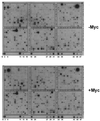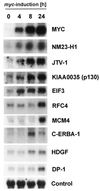The transcriptional program of a human B cell line in response to Myc
- PMID: 11139609
- PMCID: PMC29676
- DOI: 10.1093/nar/29.2.397
The transcriptional program of a human B cell line in response to Myc
Abstract
The proto-oncogene c-myc (myc) encodes a transcription factor (Myc) that promotes growth, proliferation and apoptosis. Myc has been suggested to induce these effects by induction/repression of downstream genes. Here we report the identification of potential Myc target genes in a human B cell line that grows and proliferates depending on conditional myc expression. Oligonucleotide microarrays were applied to identify downstream genes of Myc at the level of cytoplasmic mRNA. In addition, we identified potential Myc target genes in nuclear run-on experiments by changes in their transcription rate. The identified genes belong to gene classes whose products are involved in amino acid/protein synthesis, lipid metabolism, protein turnover/folding, nucleotide/DNA synthesis, transport, nucleolus function/RNA binding, transcription and splicing, oxidative stress and signal transduction. The identified targets support our current view that myc acts as a master gene for growth control and increases transcription of a large variety of genes.
Figures



References
-
- Henriksson M. and Luscher,B. (1996) Proteins of the Myc network: essential regulators of cell growth and differentiation. Adv. Cancer Res., 68, 109–182. - PubMed
-
- Cole M.D. and McMahon,S.B. (1999) The Myc oncoprotein: a critical evaluation of transactivation and target gene regulation. Oncogene, 18, 2916–2924. - PubMed
-
- Claassen G.F. and Hann,S.R. (1999) Myc-mediated transformation: the repression connection. Oncogene, 18, 2925–2933. - PubMed
-
- Luscher B. and Larsson,L.G. (1999) The basic region/helix-loop-helix/leucine zipper domain of Myc proto-oncoproteins: function and regulation. Oncogene, 18, 2955–2966. - PubMed
Publication types
MeSH terms
LinkOut - more resources
Full Text Sources
Other Literature Sources

